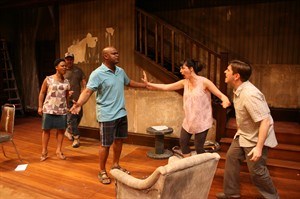
Cast members perform in "Clybourne Park" in this undated handout photo. Bruce Norris's Pulitzer Prize-winning play "Clybourne Park" traces back to his preteen days, when he saw the 1961 film "A Raisin in the Sun" that starred Sidney Poitier in school in Houston, Tex. THE CANADIAN PRESS/HO - Mirvish
February 11, 2013 - 2:00 AM
TORONTO - Bruce Norris's Pulitzer Prize-winning play "Clybourne Park" traces back to his preteen days, when he saw the 1961 film "A Raisin in the Sun" that starred Sidney Poitier in school in Houston, Tex.
"I'm white and I was raised in an all-white neighbourhood, a very segregated neighbourhood," the acclaimed playwright said in a recent telephone interview.
"And I remember thinking at the time how curious it was that our teacher was showing us a movie that had, in its plot, a group of white people who had asked some black people not to move into their neighbourhood — which was I guess subversive on the part of my teacher but I don't really know why she did it."
The idea that Norris was most like the antagonist in the story stuck with him and years later he wondered — given the milieu that he came from — what would it be like if he turned the story around and told it from the point of the view of the people who were selling their house.
The result is "Clybourne Park," Norris's play about race and real estate that runs at Toronto's Panasonic Theatre from Feb. 12 to March 3.
Mirvish Productions is presenting Studio 180 Theatre's production of the edgy comedy as part of its Off-Mirvish series (Studio 180 first presented the play's Canadian premiere in April 2012).
Joel Greenberg directs the cast of Audrey Dwyer, Michael Healey, Sterling Jarvis, Jeff Lillico, Mark McGrinder, Kimwun Perehinec and Maria Ricossa.
"Clybourne Park" premiered in February 2010 at Playwrights Horizons in New York. It then played in London and then Broadway, where it won the Tony Award for best play last June.
The story is split into two acts, set 50 years apart.
In the first act, a grieving white couple wants to sell their home in the suburban Chicago neighbourhood of Clybourne Park in 1959. Racially-charged discussions ensue when a clergyman and a neighbourhood couple tell them the family buying the house (the Youngers from "A Raisin in the Sun") is African American.
The second act is set in the same home in 2009, when Clybourne Park has become an all-black neighbourhood facing gentrification. This time, tension arises when a white couple wants to buy and replace the house.
Norris, who has worked as an actor and playwright for over 20 years, drew his inspiration for the story from Lorraine Hansberry's groundbreaking 1959 Broadway hit "A Raisin in the Sun" as well as his upbringing.
"You can't draw on what you don't know, I suppose," he said from New York City. "I hate to talk about my history, but I'm from a world that was not, shall we say, exactly progressive as concerns race — or anything for that matter, really."
Norris doesn't own property and hasn't had first-hand experience with gentrification but his contemporaries have.
"I think money is the great divider, and in the second act, the mistake that the white gentrifying couple make is that they assume that the black couple — who are their peers, since they are economically their peers, they're all young professionals — that they must be part of the same group," he said.
"And I think they realize in the course of that act that there are different dividing lines other than class. There's perhaps deeper ones, such as history and race that sometimes trump class.
"Class is the one that Americans love the most because it's about money, and that's the national religion."
Norris said he thinks society is doing a little bit better in terms of our language surrounding racism, "and the terms of the discussion have gotten a little more ... productive than they were 50 years ago.
"But I think new dimensions, new horizons for hatred are rising everyday. Now we hate Muslim immigrants, now we hate Hispanic immigrants. It's a constantly changing game to identify who the enemy is."
News from © The Canadian Press, 2013